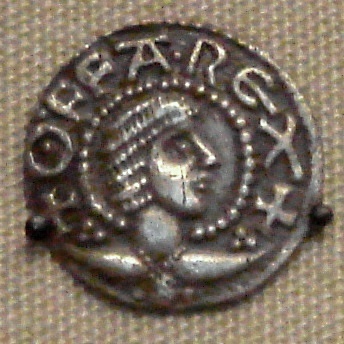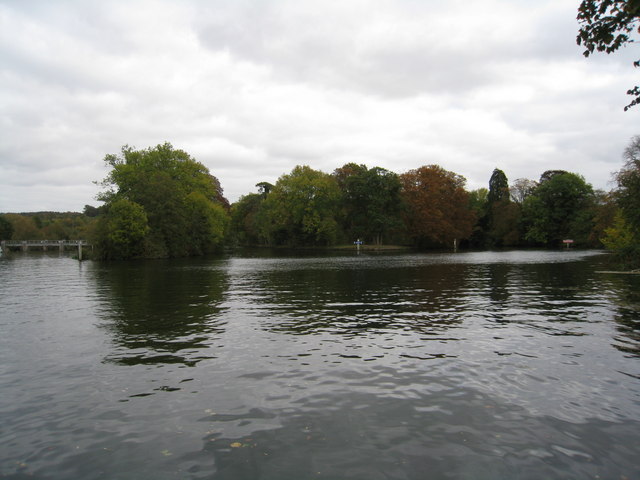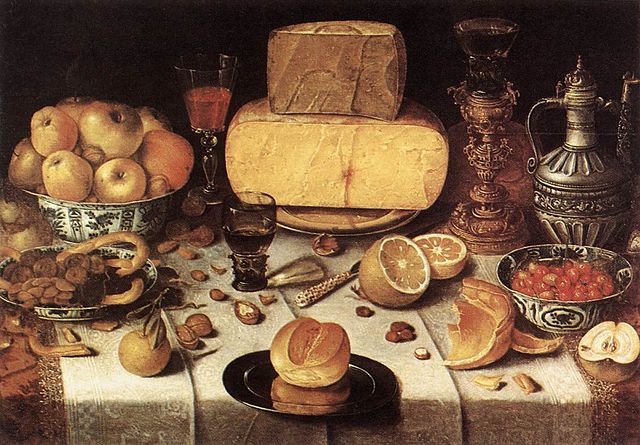by Lauren Gilbert
My husband and I recently returned from a wonderful trip, where we saw many places we had never previously visited. One of these places was a beautiful town in England named Bourton-on-the-Water, located in the Cotswolds. Some dear friends took us out for the day, and took us through several villages in the Malvern hills and the Cotswolds. Situated among rolling hills with cottages of buildings constructed of golden stone, some with thatched roofs, the villages of the Cotswolds are lovely and match every description I had ever read. Thanks to its beautiful setting, Bourton-on-the-Water has a special magic, and it has a fascinating history to go with it.
There are signs that people took advantage of the location well over 4000 years ago. Indications of a camp used by nomadic tribes consist of archaeological finds including arrow heads, flints, pottery going back to the Neolithic area, and even a pre-800 BC hand axe. The area along the river appears to have been permanently settled at least for defensive purposes sometime during the Iron Age, as indicated by a site called Salmonsbury Camp which remained a landmark in the area at least into medieval times. The Romans arrived in the area c AD 45. Roman remains including coins, buildings, roadwork, a well and two lead water storage tanks and indicate that a small Roman town was on this site. Roman troops left Britain in the 5th century, and the area was plundered by various tribes, including the Picts from Scotland, with the result that the Angles and the Saxons were invited in to help drive them back. This in turn led to issues with the Germanic people; data indicates that Bishop Germanus led a Christian army in 429 that defeated a military made up of both Picts and Saxons in 429 somewhere in the vicinity. Ultimately, the Saxons settled in the Cotswolds more or less peacefully, leaving the local inhabitants to mange themselves under their own systems. Bourton was mentioned in Saxon documents in the 8th century.
There has been a parish church in Bourton since the mid-7th century. The original Saxon church was said to have been built of wood on the site of a Roman temple, possibly in 708 when a gift of land was made by the Saxon king Oswin. This church was torn down and a new church , dedicated to Our Lady, was built on the Saxon foundations by the Normans about 1110. This church and others in the area were affiliated with Evesham Abbey. It appears that the first Norman church was replaced in the 14th century. It has been dedicated to St. Lawrence the martyr since 1328. A chantry dedicated to Our Blessed Lady was also added in the 14th century. The last Norman church was partially torn down in 1784, with the chancel being retained. The current Georgian structure was designed by local resident William Marshall and built on the same site. More rebuilding was completed during the Victorian era between 1875-1890 under the supervision of architect Sir Thomas Jackson.
During the Middle Ages, thanks to the river and the fertile land, farming expanded, as did trade. A successful wool trade resulted in the employment of two weavers, and the village also boasted a cobbler and a smith, as well as various other craftsmen. In 1381, there were 118 residents who paid poll tax. Although the Black Death troubled England from approximately 1348 to 1378, there is no record of its effect on the village. “On the Water” was not added to the name until the reign of Henry VIII. As with other parts of England, the effects on local religion with Henry VIII’s break with the Roman Catholic church and the dissolution of the monasteries, the restoration of Catholicism under Queen Mary Tudor, and the return to Protestantism under Elizabeth I were felt. As dissenting religious groups (particularly the Puritans) became established and more vocal and the Stuart kings appeared more tolerant of Catholicism, things came to a head under Charles I, largely due to taxes imposed by the king without Parliament, resulting in civil war. Armies from both sides passed through the area, although there is no indication that fighting occurred Bourton itself. King Charles and his remaining troops did stay in Bourton for one night in June 1644 after fleeing from Oxford. Charles surrendered May 6, 1646 and was executed January 30, 1649.
After the Civil War, Bourton was known to have a population of Catholics living in the area. There were also a number of nonconformists, including Puritans and Baptists (the Baptist community appears to have been established locally around 1650). Charles Stuart, Prince of Wales, was invited back to England in 1660 and was proclaimed King Charles II May 8, 1660. As a result of the restoration, tension rose between the Anglican Church and the dissenting communities. In 1660, a minister named Anthony Palmer was removed from the parish church and ejected from the Anglican Communion. He subsequently became minister to the local Congregationalists. Records indicate that, by 1676, Bourton had greater numbers of dissenters than any other community in the Stow deanery (of which Bourton was a part). Anabaptists and Presbyterians also established communities.
In August of 1876, the Baptist community in Bourton-on-the-Water opened a large new church and significantly increased its membership. While these developments occurred, the village grew and prospered. The village developed an established and prosperous middle class of business and trades people, the larger portion of whom were not Anglican. Shoemaking became a major industry of the town as the wool trade waned. The railway came through the town, with the last link completed in 1881.
Victoria Hall was built in Bourton-on-the-Water in 1897 by subscription, to celebrate Queen Victoria’s Jubilee (60 years on the throne 1837-1897). It was and still is the centre of village activities today. It boasts two plaques, one commemorating Victoria’s Jubilee, and a second honouring Queen Elizabeth II’s Jubilee (60 years on the throne 1952-2012) that were erected in 2012. The railroad and subsequent development of automobile traffic brought a thriving tourist trade to the Cotswolds, and thus to Bourton-on-the-Water. Rather than its history (of which I have touched only on parts), Bourton-on-the-Water’s lovely setting on the Windrush River, beautiful stone buildings and five stone bridges that made it a favoured destination for tourists, which it is to this day. It’s no wonder that Bourton-on-the-Water is listed as one of England’s “Venice of the North” cities.
Sources include:
Wray, Tony and Stratford, David. Bourton on the Water. (Towns and Villages of England) Sutton Publishing Limited: Gloucestershire, 1994, reprinted 2004.
Britain Express. “Bourton on the Water, Gloucestershire” by David Ross. HERE
British History Online. “Parishes: Bourton-on-the-Water.” From A History of the County of Gloucester: Volume 6. Originally published by Victoria County History, London, 1965, Pages 33-49.
Cotswolds.Info “History of Bourton-on-the-Water” by Ralph Green. HERE
Historic England. “Iron Age fortified enclosure known as Salmonsbury Camp.” HERE
~~~~~~~~~~~~
 About the Author:
About the Author:
Lauren Gilbert, author of HEYERWOOD: A Novel, holds a bachelor of arts degree in English, and is a long-time member of the Jane Austen Society of North America. Her second novel, A RATIONAL ATTACHMENT is in process and she is engaged in research for a biography. She lives in Florida with her husband. You can find out more on her Amazon page.
 |
| A view of Bourton-on-the-Water taken by the author 2018 |
My husband and I recently returned from a wonderful trip, where we saw many places we had never previously visited. One of these places was a beautiful town in England named Bourton-on-the-Water, located in the Cotswolds. Some dear friends took us out for the day, and took us through several villages in the Malvern hills and the Cotswolds. Situated among rolling hills with cottages of buildings constructed of golden stone, some with thatched roofs, the villages of the Cotswolds are lovely and match every description I had ever read. Thanks to its beautiful setting, Bourton-on-the-Water has a special magic, and it has a fascinating history to go with it.
There are signs that people took advantage of the location well over 4000 years ago. Indications of a camp used by nomadic tribes consist of archaeological finds including arrow heads, flints, pottery going back to the Neolithic area, and even a pre-800 BC hand axe. The area along the river appears to have been permanently settled at least for defensive purposes sometime during the Iron Age, as indicated by a site called Salmonsbury Camp which remained a landmark in the area at least into medieval times. The Romans arrived in the area c AD 45. Roman remains including coins, buildings, roadwork, a well and two lead water storage tanks and indicate that a small Roman town was on this site. Roman troops left Britain in the 5th century, and the area was plundered by various tribes, including the Picts from Scotland, with the result that the Angles and the Saxons were invited in to help drive them back. This in turn led to issues with the Germanic people; data indicates that Bishop Germanus led a Christian army in 429 that defeated a military made up of both Picts and Saxons in 429 somewhere in the vicinity. Ultimately, the Saxons settled in the Cotswolds more or less peacefully, leaving the local inhabitants to mange themselves under their own systems. Bourton was mentioned in Saxon documents in the 8th century.
There has been a parish church in Bourton since the mid-7th century. The original Saxon church was said to have been built of wood on the site of a Roman temple, possibly in 708 when a gift of land was made by the Saxon king Oswin. This church was torn down and a new church , dedicated to Our Lady, was built on the Saxon foundations by the Normans about 1110. This church and others in the area were affiliated with Evesham Abbey. It appears that the first Norman church was replaced in the 14th century. It has been dedicated to St. Lawrence the martyr since 1328. A chantry dedicated to Our Blessed Lady was also added in the 14th century. The last Norman church was partially torn down in 1784, with the chancel being retained. The current Georgian structure was designed by local resident William Marshall and built on the same site. More rebuilding was completed during the Victorian era between 1875-1890 under the supervision of architect Sir Thomas Jackson.
.jpg/680px-St_Lawrence's_Church%2C_Bourton-on-the-Water_(1368).jpg) |
| St Lawrence's Church, Bourton-on-the-Water (by Nilfanion [CC BY-SA 4.0, via Wikimedia Commons) |
During the Middle Ages, thanks to the river and the fertile land, farming expanded, as did trade. A successful wool trade resulted in the employment of two weavers, and the village also boasted a cobbler and a smith, as well as various other craftsmen. In 1381, there were 118 residents who paid poll tax. Although the Black Death troubled England from approximately 1348 to 1378, there is no record of its effect on the village. “On the Water” was not added to the name until the reign of Henry VIII. As with other parts of England, the effects on local religion with Henry VIII’s break with the Roman Catholic church and the dissolution of the monasteries, the restoration of Catholicism under Queen Mary Tudor, and the return to Protestantism under Elizabeth I were felt. As dissenting religious groups (particularly the Puritans) became established and more vocal and the Stuart kings appeared more tolerant of Catholicism, things came to a head under Charles I, largely due to taxes imposed by the king without Parliament, resulting in civil war. Armies from both sides passed through the area, although there is no indication that fighting occurred Bourton itself. King Charles and his remaining troops did stay in Bourton for one night in June 1644 after fleeing from Oxford. Charles surrendered May 6, 1646 and was executed January 30, 1649.
After the Civil War, Bourton was known to have a population of Catholics living in the area. There were also a number of nonconformists, including Puritans and Baptists (the Baptist community appears to have been established locally around 1650). Charles Stuart, Prince of Wales, was invited back to England in 1660 and was proclaimed King Charles II May 8, 1660. As a result of the restoration, tension rose between the Anglican Church and the dissenting communities. In 1660, a minister named Anthony Palmer was removed from the parish church and ejected from the Anglican Communion. He subsequently became minister to the local Congregationalists. Records indicate that, by 1676, Bourton had greater numbers of dissenters than any other community in the Stow deanery (of which Bourton was a part). Anabaptists and Presbyterians also established communities.
In August of 1876, the Baptist community in Bourton-on-the-Water opened a large new church and significantly increased its membership. While these developments occurred, the village grew and prospered. The village developed an established and prosperous middle class of business and trades people, the larger portion of whom were not Anglican. Shoemaking became a major industry of the town as the wool trade waned. The railway came through the town, with the last link completed in 1881.
Victoria Hall was built in Bourton-on-the-Water in 1897 by subscription, to celebrate Queen Victoria’s Jubilee (60 years on the throne 1837-1897). It was and still is the centre of village activities today. It boasts two plaques, one commemorating Victoria’s Jubilee, and a second honouring Queen Elizabeth II’s Jubilee (60 years on the throne 1952-2012) that were erected in 2012. The railroad and subsequent development of automobile traffic brought a thriving tourist trade to the Cotswolds, and thus to Bourton-on-the-Water. Rather than its history (of which I have touched only on parts), Bourton-on-the-Water’s lovely setting on the Windrush River, beautiful stone buildings and five stone bridges that made it a favoured destination for tourists, which it is to this day. It’s no wonder that Bourton-on-the-Water is listed as one of England’s “Venice of the North” cities.
 |
| Victoria Hall (on the right) taken by the author 2018 |
Sources include:
Wray, Tony and Stratford, David. Bourton on the Water. (Towns and Villages of England) Sutton Publishing Limited: Gloucestershire, 1994, reprinted 2004.
Britain Express. “Bourton on the Water, Gloucestershire” by David Ross. HERE
British History Online. “Parishes: Bourton-on-the-Water.” From A History of the County of Gloucester: Volume 6. Originally published by Victoria County History, London, 1965, Pages 33-49.
Cotswolds.Info “History of Bourton-on-the-Water” by Ralph Green. HERE
Historic England. “Iron Age fortified enclosure known as Salmonsbury Camp.” HERE
 About the Author:
About the Author:Lauren Gilbert, author of HEYERWOOD: A Novel, holds a bachelor of arts degree in English, and is a long-time member of the Jane Austen Society of North America. Her second novel, A RATIONAL ATTACHMENT is in process and she is engaged in research for a biography. She lives in Florida with her husband. You can find out more on her Amazon page.


































.jpg)





